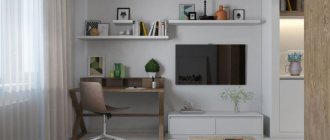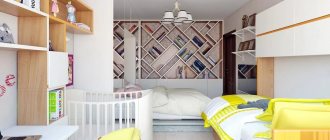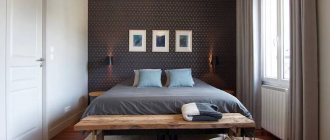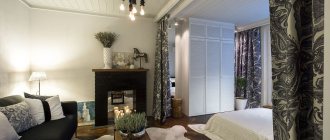Photo: almode.ru Combining a bedroom with a living room is most often a necessary measure, because in a one-room apartment there are not many options. The fashion for open spaces and free layouts has contributed to the development of a lot of interesting solutions and design projects. We have collected the most interesting and practical options in this material, and we are ready to present them to you!
How to arrange a living room with a sleeping place
When planning the furnishings when combining a living room and a bedroom, you must proceed from the area of the room. Actually, there are several ways.
One of the options for equipping a living room-bedroom in one room
- Do not delimit the space, but use transformable furniture. In particular, a bed built into a closet or a sofa bed, but not in the old version, but in the new one (one example is shown in the photo).
- Separate the space for the bed by separating it with a stationary or sliding partition.
- Separate the bed with a screen or curtains.
- Use furniture (wardrobe, shelves, etc.) for zoning.
One way to highlight the bedroom area in the living room is a partition, but not at full height. This is a view of the bedroom from the living room
If the living room and bedroom are small (less than 16 square meters) or it is not possible to install a bed and sofa due to the layout, there is only one solution - to use transformable furniture. If the area allows, you can use any of the methods.
In the style of minimalism
Bedroom - living room, decorated in a minimalist style, ideal for a small space. The minimalist style is designed to create a functional space with several zones. At the same time, the room will look spacious and bright.
Zoning a bedroom in a one-room apartment Source elnikova.com
The peculiarity of the style is as follows:
- Use of furniture with transformation function. Each piece of furniture can perform several tasks.
- Calm color scheme, consisting of two or three shades.
- The furniture has clear geometric shapes and lines, as well as smooth fronts. Glossy surfaces visually enlarge the room.
- A minimum number of furnishings are used in the room - only the most necessary.
- Textured surfaces of furniture and decoration serve as decor.
- Much attention is paid to natural and artificial lighting. Therefore, the windows are not draped with heavy curtains, but are equipped with modern blinds or roller blinds. In the bedroom area, if it is located near the window, you can use straight-cut plain thick curtains.
- Only natural materials are used in decoration - glass, wood, stone.
- The most preferred are white, beige, brick, ash and sand shades.
Zoning a one-room apartment with curtains Source dizainvfoto.ru
To make the minimalist style comfortable and functional, you should adhere to the following rules:
- When decorating a room, consider proportions.
- Use design techniques for zoning space.
- Remove excess furniture and decor.
- Provide maximum amount of natural light.
- Use a calm color scheme.
The minimalist style allows the use of furniture with glossy surfaces, glass and mirror elements. But carved decor should be abandoned - the surfaces should be smooth and even. Furniture facades are blank, without open shelves and glass doors.
A small partition between zones Source timeszp.com
How to divide a room into zones
To decide whether you can have two separate zones in the room or not, you need to first evaluate everything on the plan. This can be done in design programs that allow you to obtain a two or even three-dimensional image. If working with programs does not seem attractive to you, you can get by with two sheets of thick paper or cardboard.
One of the programs...
To evaluate zoning options manually, you will need a floor plan with dimensions drawn to scale. Display on it where the windows and doors are located (also with dimensions). Next, you need to think about where you would like to place the bed, where is the sofa for guests. For the living room-bedroom, these are the two key items that they try to put first. It is better to cut them out of cardboard, and also to scale. You will also need to cut out from cardboard the furniture that is necessary and must be there. If you don't have one yet, cut them out in the sizes you want. Then you can make adjustments.
On paper it looks something like this
The resulting set of “furniture” can be moved according to the room plan, finding possible options for the location of zones. If there are several options, sketch, sign where and what you will put, putting down the dimensions of the furniture and the passages between them. Then it will be possible for everyone to think about what type of zoning can be applied in each option. The program works approximately the same way, only the movement is virtual. Using a program or layouts, you will understand whether you can select two separate zones, while determining the size of each of them. If it is not possible to separate separate zones, you will have to make do with folding furniture.
Wood and gypsum panels
Decorative panels with carved relief have long had a lot of fans, never ceasing to delight with their stylish design. Manufacturers market both solid and openwork models. However, it is the second type of design that has gained great popularity.
With this approach to planning, it will not be possible to completely isolate the room from noise and odors. However, the advantages of the choice include sufficient strength of the material, absolute safety for humans, and a pleasant design.
Solution for small rooms
Arranging small rooms requires a special approach. Creating an interior is an art, and the design of a small room, and even a multifunctional one, is generally akin to circus art. Even the little things are important here.
For a small living room bedroom you need to think through everything to the smallest detail
Let's start with what is considered a small room in this case. In general, it is believed that a room with an area of 14-16 meters is rather large. But in the case of the need to accommodate two zones - a living room and a bedroom - this is really very little. These are the types of rooms - up to 16 square meters - and we will accept them as small ones. If the area is 18-20 meters or more, these are already “normal” sizes in which the living room and bedroom can be divided using any zoning techniques.
Using customizable furniture
In a small room, it is not always possible to combine a living room and a bedroom, while installing a full-size bed. But you can always put a transformable sofa instead of a regular sofa. This is not a sofa bed on which you can only sleep conditionally. Modern transformable furniture can provide the same level of comfort as a regular stationary bed. There are models with orthopedic mattresses. Width ranges from single to full double.
Wardrobe that turns into a bed
Can be converted into a double bed:
- Closet. When closed, it looks like an ordinary wardrobe; it folds back and becomes a bed.
- Sofa. This type of furniture in the “day” position is similar to a sofa that stands near the closet; in the “night” position, the bed lowers, crushing the sofa under itself.
The options described above require a free space of at least 220-250 cm in front of the sofa or closet (depending on the model). And after the bed is in place, there should be at least a narrow passage left. So, in fact, the distance to the transformable furniture should be at least 280 cm. But you get a full-fledged double bed. The mattress can even be orthopedic.
This is an interesting transformation
There are also options for single or single beds. In them, the base of the bed is attached to the furniture with the long side. They require less free space - no more than 200 cm in the case of a one-and-a-half bed or 150 cm in the case of a single bed.
Unusual ways
There is one non-trivial option for how you can highlight the bedroom area in the living room: make a podium on which to place some area. There you can place, for example, several armchairs and a coffee table or place a sofa. Push the bed under the podium.
Make a podium and roll up a bed under it for the day (you can make a chest of drawers from the steps)
With this solution, the flooring must be of sufficient height so that the bed can be hidden under it. Long and narrow rooms, also called trailers, are ideal for this solution.
Another option for the young and active: move the bedroom to a closet. A square or rectangle of sufficient area to accommodate a sleeping place is assembled from cabinet furniture (high shelves, cabinets). You can do this using plasterboard partitions (as in the photo). On one side a staircase is built in/attached, along which one climbs up “to the bedroom”.
Here's an unusual way to separate the living room and bedroom
It turns out to be a living room-bedroom without reducing the living room area. You can even make the room even more multifunctional: arrange a workplace or mini-office in a space fenced off with furniture. This is an excellent option for a small studio apartment where young people live.
All this is not bad, but it is worth knowing about the disadvantages. First, the solutions are not cheap. Transformable furniture costs a lot, as does making a podium with sufficient load-bearing capacity. Secondly, every evening and every morning, in order to get and hide a sleeping place, you will have to make certain body movements. This only seems easy at first. In fact, it gets boring pretty quickly...until it becomes a habit.
Decorative curtains
An interesting way to divide a room into two zones is to use decorative curtains made from thick textiles. Such accessories are mounted on special ceiling cornices that can withstand significant loads. Using curtains has certain advantages:
- The curtains can be pulled apart during the day and the bed can be hidden behind them at night.
- There is always the option of using double curtains. Light mesh tulle will protect you from insects during the day.
- Some types of textiles absorb sounds and unpleasant odors well.
- Modern curtain models create an original interior for the living room combined with the bedroom.
When choosing a fabric base, you should focus on the quality composition of the material, practical care features and resistance to shrinkage (with frequent washing).
Choose a place for the sleeping area
When dividing rooms into a bedroom and a living room, first of all you need to decide where you want to make the bedroom. Most often, the corner farthest from the entrance is chosen. This makes sense, since the bedroom requires the greatest degree of privacy.
If there is a window in the separated area, you will have to make sure that there is enough light in the rest of the room. Glass partitions, separation using screens or curtains, specially created translucent shelves help with this.
The bed in the living room with a separate bedroom is usually placed further away from the entrance
In the opposite situation - if the window is in the living room area, the situation is slightly better. Firstly, the bedroom is usually used at night. So natural light is not such a necessity. Although we are accustomed to the fact that it should be. There are two solutions: make the division so that there is enough light or get what is missing by installing additional lamps.
Lighting
It’s easy to zone a space using a variety of products. LED strip, table and wall lamps of different designs can clearly and unobtrusively separate the sleeping area from the guest area. At the same time, flows of light in different directions will give the atmosphere uniqueness and visually delimit the room.
Lighting is another easy way to separate rooms
Paired installation of sconces or floor lamps in the sleeping area will replace natural lighting. A chandelier or a row of spotlights is the center, and spotlights illuminating paintings or photographs create a cozy atmosphere in the living area.
Zoning the living room-bedroom with partitions
For zoning, partitions made of plasterboard and glass are used. The installation of both is not a redevelopment, so it does not require approval.
Not everyone likes the idea of putting a room divider. But it may not be whole. Very often, a “monolithic” partition is erected to a height of a meter or a little more, and above that they make something openwork that allows light to pass through. This solves the problem of natural lighting and the structure does not look as heavy as a wall.
Partitions - they are different. Also a good way to isolate a bed. Openwork things are made from plasterboard.
Also an option
The upper part can be designed in different ways. If you want physical separation, but without much loss of light, it could be patterned, frosted, colored glass. Do not be afraid that the glass partition is fragile - it can withstand loads greater than drywall.
Other options: various types of wood and metal products. There are a lot of options - from functional or decorative shelves, to pins made of wood, metal, bamboo, etc. simply installed in a certain order (or without it).
TOP 14 recommendations for combined premises
1 refuse bulky furniture;
2avoid models with an elaborate design;
3choose cabinets and shelves with glass inserts or through ones with high legs;
4do not use wallpaper and window curtains with large images for wall cladding, so as not to visually reduce the space;
5use plain materials for background design;
6an excellent accent for a certain area - a panel or a photo gallery;
7use roller curtains instead of classic ones;
8 solid glass partitions will create the impression of an ultra-fashionable interior;
9 for sufficient lighting it is better to use transparent materials;
10it is necessary to choose products made of tempered glass that do not form sharp fragments;
11 stained glass or tinted surfaces will protect the bedroom from bright light;
12 purchase a podium with full-roll-out guides that can withstand more weight;
13use furniture without legs to make the room visually more spacious;
14 use soft ottomans instead of armchairs.
An original way of zoning
Where is the best place to put the bed?
If there is a bay window, the sleeping area is usually placed there, and the guest area in the rest of the space. The area of the bay window, which is usually slightly larger than the dimensions of a double bed, does not allow doing the opposite.
Designate a place for the bed so that it does not disturb you or your guests
In other cases, it is better to place the sleeping area in the farthest corner from the doorway because this is the least accessible area in the room. In addition, the presence of natural light does not play a special role for sleep. Wall and ceiling light sources, sconces and table lamps perform its functions perfectly.
A common method is to install a bed behind the backs of a pair of chairs or a rectangular sofa . With this layout, we look at the decor of the wall surface at the head of the bed.
Popular method of dividing into zones
When using a low through shelving, the bedroom is located both at the entrance to the room and next to the window.
Separating zones with screens
You can create zoning in the living room and bedroom using screens. This is a quick and inexpensive way to zone the living room and bedroom in one room. Do not think that this method is outdated and irrelevant. If you choose the right textures, materials, colors, everything looks very stylish, original and appropriate.
Option for a translucent partition for zoning the living room and bedroom
A portable screen can be stylish. You can even use a rope curtain as a screen. The main thing is the visual delimitation of space Light mobile curtain
Openwork is good in classic interiors
There are traditional screens - portable, folding. But it is far from necessary that they have an “old-regime” appearance. No, traditional-type screens - covered with tapestries - are good for classic interiors. And those that come from the “sixties” - painted, made of wood and plywood - look great in a loft or art deco. If your living room or bedroom is decorated in this style, it will not be difficult for you to find the right option. But modern interiors require other materials and textures, and here you will have to try.
Glass screens
Glass screens are ideal for modern style, minimalism, and hi-tech. It’s just that you have to choose different glass. For hi-tech and minimalism, the best option is tinted with a silver coating, reminiscent of a mirror. White, milky, gray will look good - depending on the design of the bedroom-living room. A living room bedroom in Provence style can also be equipped with a screen made of painted plywood. But if you don’t like a too “rural” option, you can add a glass screen with photo printing. You can choose one of the landscapes that are typical for the south of France, use colored glass with floral patterns.
The frame is made of metal, the filling is frosted glass or sheet polycarbonate
Milk glass is opaque, but allows enough light to pass through
A look from the other side An interesting option with patterned glass
Glass mobile screen of a traditional type. Patterns are applied using a sandblaster.
And again, don’t think that glass is fragile. For such products they use hardened or laminated (duplex and triplex), and they are stronger than many sheet materials.
From other materials
If you still don’t like glass, you can make or look for partitions made of plastic, wood, etc. You can make a wooden screen into a wooden house. If you know how to work with wood, this will not be difficult, since the design is simple. You can imitate a wall, you can make a lighter, openwork design. Again, everything depends on the style in which the living room and bedroom are decorated.
A patterned plastic partition visually separates zones from one another
The simplest wooden screen made of rods or planks
Carved wood panels require more skill
Metal openwork….
If wood is only found in some decorative items, frames are made from it, and the filling is selected according to your own taste. After all, it could be fabric. The same as on curtains or upholstery. You can use fiberboard laminated to match the furniture, plywood or thin chipboard. You can even assemble such a screen from drywall and cover it with wallpaper or paint it - it will be a movable wall.
For a modern style, you can use well-aimed branches painted in the main or one of the additional colors. They are attached to frames along or across to create a translucent screen. Bamboo, metal rods, etc. can be secured in the same way. In general, as usual in interior design, this is a creative process.
Sliding screens
A few more words about sliding screens. They are in a separate class, since they are not as “nailed into place” as stationary partitions, but also not as mobile as portable screens. A very good option for zoning the living room and bedroom into one room if you want to have a secluded corner for relaxation.
Sliding screens can be of three types. They can move like sliding doors, fold like a book or an accordion. For all of them, the bottom needs guides that are attached either to the ceiling, or to the floor, or to both the floor and the ceiling at the same time. Only screens with a bottom guide can not reach the ceiling, but they are the most unstable. If you have children or are not sure that you will use them carefully, it is better to use floor-to-ceiling models.
Sliding screens are made like compartment doors Living room bedroom with division of zones using sliding screens With a slight touch of oriental style Geometry always looks good
The material for screens of this type is any sheet: glass, plastic, laminated fiberboard, MDF. You can look for similar systems in companies that deal with sliding wardrobes. Doors for sliding wardrobes are made using the same system and partitions are no different.
Color
The main rule that the owner of a living room of 15 m2 should take into account is the play of colors. In order to visually expand the space of a small room, follow these recommendations:
- Use pastel colors in the basic finish of the main surface. Adding variety is done by focusing on one of the walls. You can make it brighter or stick on photo wallpaper that has the effect of expanding space (landscape, wide panoramic window, optical illusion).
- Opt for a neutral white or light gray shade. They can be diluted with ivory, soft milky, beige, pale pink, light green or soft blue splashes.
- Follow the rule of a primary color, diluted with two additional ones. In such a composition, the color scheme will not give the impression of an overloaded interior.
- Furniture, doors and decorative elements are selected taking into account the shade of the flooring, wall surfaces and ceilings. In this case, you can focus on 1-2 objects of a dark tone. This could be upholstered furniture, a table or something else. All other attributes are selected 1-2 tones lighter than the main interior.
The interior is in harmony with the colors of the living room Source pinimg.com Living room of 15 m2 with dark tones Source mtdata.ru
Zoning with curtains
An even more inexpensive way is to have a living room/bedroom divided into zones by curtains. All that is required is to select and secure curtain rods. Then select fabrics and sew panels of the required sizes. The fabrics used are the same as for windows and they do not have to be thick, although this option is possible.
Curtains can be without folds - in the Japanese style. Draperies around the perimeter - to create coziness. Visible division
Double curtains - it is important to choose the right curtain rods
The drapery can cover only the “clearance”, or it can also go along the walls, creating a cozy atmosphere. But this option will still require quite a bit of money, since you need a lot of fabric.
Such zoning of the bedroom and living room combined in one room is nominal, but creates the required feeling of privacy. It can be used in the version with portable screens as a temporary option - if you just can’t decide where exactly to place the bedroom and living room areas, or how to distribute the area between them.
Peculiarities
The bedroom-living room is most often formed from a cramped two-room “Khrushchev” apartment, which often has an extremely inconvenient layout and a small kitchen. The combined room is quite spacious - due to the demolition of “extra” walls, more space appears for comfortable movement, beautiful arrangement of furniture; the separation of the living and sleeping areas here is purely symbolic.
There is also another option - a one-room apartment, the only living space of which is limited to an area of 15 or 16 square meters, less often - 17-23 m. It is problematic to accommodate the whole family here, therefore competent zoning is vital, especially if you have a child. If you have a spacious kitchen, several “squares” are “cut off” from it in favor of the room by moving the wall.
Any redevelopment options can disrupt the structure of the building, which often leads to collapse. Before starting work, the project must be coordinated with higher authorities and obtain the appropriate permission.
Using furniture to separate
It is not always possible to allocate even a small piece of space in a small room under a non-functional partition. Moreover, furniture can perform the same task. Usually this is a closet or high shelves.
Most often, the lower part of the furniture is made without gaps (about a meter high). I make this part in the form of a cabinet or chest of drawers. The top one is usually made with through gaps. This way the furniture doesn’t look so bulky and doesn’t “clog” the space. In addition, this solution allows you to maintain natural light in both parts of the room.
A cabinet or chest of drawers is made in the lower part, shelves are made above
Non-linear shape adds originality
A look from the other side
The main thing is not to clutter the shelves
When developing the concept of such furniture or looking for ready-made options, keep in mind that all horizontal surfaces collect dust well. Each shelf is a dust collector. If they are not planned to be used, it is better to make as few horizontal lines as possible. It is better to hang several decorative items in the spaces between the racks. They collect much less dust, and perhaps look more original.
Advantages and disadvantages
Combining two rooms into one has its pros and cons.
Positive sides:
- the ability to create interesting designs;
- everything you need for life will be compactly placed in a small area;
- each family member will be able to allocate their own corner;
- the place where there used to be a wall is also fully used;
- many zoning elements can be easily removed when they are not needed.
Negative points:
- there is no soundproofing of the bedroom;
- the privacy of the sleeping area is much less than in separate rooms;
- difficulties with the correct zoning of the resulting territory.
The area and design of each zone depends on the functions assigned to them and the number of people living in the apartment.
Living room bedroom: additional zoning techniques
In addition to physical separation, zoning the living room-bedroom in one room can be done using:
- Changes in floor and ceiling levels. For example, the bedroom area can be raised a little, and to further emphasize the division, you can use different flooring. It can be the same in color, but different in texture or material. For example, lay laminate flooring in the living room area and carpet in the bedroom area. You can also use different colors.
Different wall colors are one of the means of zoning. So the living room and bedroom clearly have two parts with different purposes.
Separation by color
The podium is not small... but it can be 5-10 cm high
- Decorate the walls with different colors. You can use wallpaper of two colors, but with the same texture, paint it in a different color, etc.
- Different texture of the walls. In the living room, for example, there is decorative plaster of the Venetian type, in the bedroom there is liquid wallpaper.
These techniques will also help you zone your living room. But when choosing colors, you must be guided by the principles of color compatibility. Then you will be able to create a harmonious interior.
Color spectrum
Color is one of the most powerful tools for zoning and visually changing space. In the combined bedroom-living room, use those shades in which you feel comfortable being and relaxing. Too flashy, flashy and aggressive colors will tire you over time if you spend day and night wearing them.
Plain finish
The easiest way to harmoniously combine space is a calm, monochromatic background. Paint all the walls the same color or wallpaper them in a small, barely noticeable pattern - and the room will immediately become complete. And even scattered furniture will not be so conspicuous.
Contrasting accents
Contrasting or bright inserts, stripes, accent walls - all this helps change the space and gives it personality. Pronounced verticals visually raise the ceiling, and horizontal lines push the walls apart. A bright sofa or blanket will breathe freshness into the interior, colorful posters will create an atmosphere of light creative chaos, and a green corner will add coziness.
Adjacent shades
If a single-color finish is too boring and bland for you, use the fashionable technique of combining several variations of adjacent tones. After all, even white can be different, not to mention dozens of interpretations of blue, green, red or yellow.
Neutral range
If you prefer proven classics, then all the classic combinations are win-win for you: black and white, brown and beige, a variety of gray or natural green. Many popular trends of minimalism, Scandinavian style and neoclassicism are still based on this range.
Turquoise kitchen: 80 beautiful design ideas (photos)











